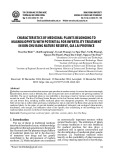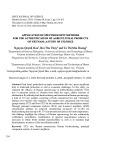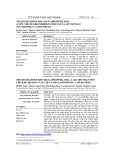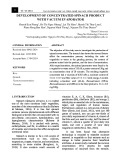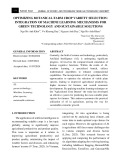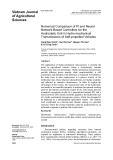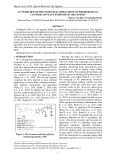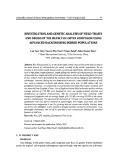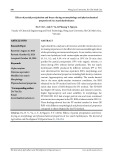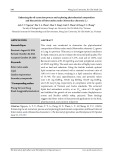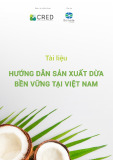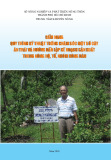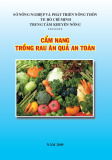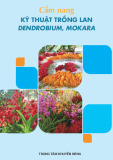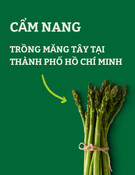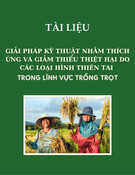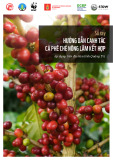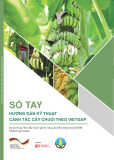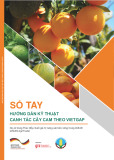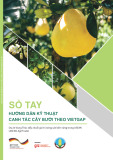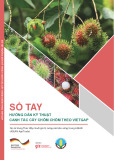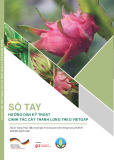
Vietnam Journal
of Agricultural
Sciences
ISSN 2588-1299
VJAS 2023; 6(4): 1969-1977
https://doi.org/10.31817/vjas.2023.6.4.07
1969
Vietnam Journal of Agricultural Sciences
Received: June 12, 2023
Accepted: December 17, 2023
Correspondence to
dttai@vnua.edu.vn
Inhibitory Effects of Ludwigia Octovalvis
(Jacq.) Raven Extracts on the Growth of
Microcystis Aeruginosa
Nguyen Xuan Hoa, Tran Thi Thuy, Vu Thi Huyen, Phung Thi
Vinh, Pham Trung Duc & Doan Thi Thuy Ai*
Faculty of Natural Resources and Environment, Vietnam National University of
Agriculture, Hanoi 131000, Vietnam
Abstract
This study examined the phytochemical composition and algicidal
effectiveness of Ludwigia octovalvis. The powder samples were
extracted by ultrasound-assisted extraction with polar solvents
(water-diluted ethanol, acetone, methanol, and water). The
preliminary phytochemical analyses used standard procedures
following Sofowora and Harborne. Total phenolic contents in
extracts were determined by the Folin-Ciocalteu method using
a calibration curve of gallic acid. The results showed that this plant
contains polyphenols, flavonoids, anthraquinones, glycosides, and
saponins. The best conditions for the extraction of polyphenol
compounds with a total polyphenol content of 149.22 ± 0.96 mg GAE
g-1 were acetone/water 70:30 (v/v) and a solvent-to-material ratio of
20 mL g-1. The inhibitory effect of the extracts against M. aeruginosa
growth increased from 40.71 to 81.56% on day 7 when exposed to
concentrations of the extract from 50-200 μg mL-1 according to the
cell counting method. The L. octovalvis extract was identified as an
effective inhibitor of the growth of M. aeruginosa.
Keywords
Algae, cyanobacteria, Microcystis aeruginosa, Ludwigia octovalvis,
Onagraceae
Introduction
Microcystis aeruginosa is one of the most common types of
toxic cyanobacteria. It produces cyclic peptide compounds called
microcystins (Ding et al., 1998; Oh et al., 2000), which cause many
serious diseases in animals and humans (Nishiwaki-Matsushima et
al., 1992; Rao et al., 1995). Therefore, controlling M.
aeruginosa growth is one of the most important solutions to deal with
environmental pollution caused by toxic algae.
Previous research has documented the use of substances such
as copper sulfate (Han et al., 2001), potassium permanganate,

Inhibitory effects of Ludwigia octovalvis (Jacq.) raven extracts on the growth of Microcystis aeruginosa
1970
Vietnam Journal of Agricultural Sciences
hydroperoxide (Jančula & Maršálek, 2011; Fan et
al., 2014), and nano metals or metal oxides as
algicidal agents (Karan et al., 1998; Sankar et al.,
2014). These chemical algicides can remove
toxic algae easily and quickly. However, due to
their non-selective characteristics, they can be
harmful to fish and other aquatic animals, so they
also cause secondary pollution and lead to the
deterioration of water quality.
Utilizing allelopathic plant compounds as
substitutes for traditional algicidal drugs has
emerged as a highly intriguing strategy in recent
years to manage cyanobacteria outbreaks.
Numerous researchers have examined the ability
of plant extracts and bioactive substances to
inhibit the growth of M. aeruginosa (Barrett et
al., 1999; Shao et al., 2013; Meng et al., 2015;
Nga et al., 2017). Polyphenols are organic
substances that have a variety of fascinating
biological functions, including having
antioxidant, antiviral, and antibacterial
properties. These compounds have been
identified as the primary bioactive components in
herbal extracts that prevent cyanobacteria from
growing (Pillinger et al., 1994; Nakai et al.,
2001; Huang et al., 2015; Tebaa et al., 2017). By
bioassay-guided fractionation, eugeniin and its
derivatives, ellagic and gallic acids, were
obtained from Myriophyllum spicatum, and all of
these polyphenols showed significant inhibitory
activity in the growth of M. aeruginosa (Gross et
al., 1996). M. aeruginosa growth was also
inhibited by p coumaric acid and vanillic acid,
with EC50 values of 0.26 ± 0.07 and 0.34 ± 0.05
mmol L-1, respectively (Zhang et al., 2010).
Ludwigia octovalvis (Jacq.) Raven belongs
to the family Onagraceae. The tree is an
undershrub, erect, up to 2.5m high, well-
branched, and widely distributed in America,
Africa, Asia, and Australia (Chen et al., 2007).
The plant is a traditional herbal remedy in
Vietnam to treat gastrointestinal conditions like
flatulence and diarrhea.
Several Ludwigia species have been studied
to learn more about their chemical compositions
and bioactivities, including L. octovalvis, L.
hyssopifolia, L. adscendes, L. leptocarpa, and L.
peploides. Previous studies have shown
that Ludwigia species are diverse in polyphenol
compounds and have many bioactivities such as
having antioxidant, antimicrobial, and anticancer
properties (Wu et al., 2010; Yakob et al., 2012;
Yakob et al., 2015; Smida et al., 2018; Baky et
al., 2022; Shawky et al., 2023). However, the
plants have not yet been studied in terms of their
ability to inhibit the growth of cyanobacteria.
In this study, we concentrated on the
identification of the phytochemicals present in L.
octovalvis, the preparation of a rich polyphenol
extract from L. octovalvis, and the evaluation of
the growth-inhibitory effects of the extract on M.
aeruginosa bacteria.
Materials and Methodology
Materials
The cyanobacterium M. aeruginosa was
collected from four lakes at Vietnam National
University of Agriculture (VNUA) in 2019 and
cultured in nutrient B12-medium, with
approximately 40 µmol photons m-2 s-1 provided
by cool white fluorescent lamps, a temperature of
28oC, and a light cycle of (12 light: 12 dark)
following the previously reported methods of
Nakagawa et al. (1987).
The aerial parts of L. octovalvis were
collected in February 2019 from Hung Yen
province, Vietnam, air-dried in the shade, and
ground to a powder. The plant was identified by
Dr. Do Van Truong, Department of Biology,
Vietnam Academy of Science and Technology.
A voucher specimen (VTH-01) was deposited at
the Department of Biology, Vietnam National
Museum of Nature.
Chemicals
Folin-Ciocalteu reagent and gallic acid were
purchased from Sigma-Aldrich (USA).
NaNO3, K2HPO4, MgSO4-7H2O, CaCl2-2H2O,
ferric citrate, Na2EDTA, Na2CO3, FeCl3,
vitamin B12 (China) to form the nutrient B12-
medium, solvents, and other chemicals were of
analytical grade.

Nguyen Xuan Hoa et al. (2023)
https://vjas.vnua.edu.vn/
1971
(a)
(b)
(c)
Figure 1. The materials
a, b/ Twigs of L.octovalvis with flowers; c/ M.aeruginosa
Methods
Phytochemical screening
The phytochemical tests were performed on
the L. octovalvis extracts using standard methods
(Sofowora, 1996; Harborne, 1998). Secondary
groups, namely phenolics, flavonoids,
anthraquinones, glycosides, and saponins, were
identified in this work.
(i) Test for phenolics
Two milliliters (2mL) of iron (III) chloride
1% was added to 2mL of L. octovalvis extract. A
bluish-green or green color showed the presence
of phenols.
(ii) Test for flavonoids
Flavonoids were indicated by the alkaline
test. A few drops of 2M sodium hydroxide
solution was added to 2mL of extract. The
presence of flavonoids changed the color of the
solution to yellow or red.
(iii) Test for anthraquinones
A mixture of extract and H2SO4 3M was
shaken and extracted with chloroform. The
chloroform layer was diluted with ammonia
10%. A pink aqueous ammonia layer indicated
the presence of anthraquinones.
(iv) Test for glycosides
Two milliliters (2mL) of acetic acid and
2mL of chloroform were added to 2mL of the
extract. The solution was cooled and
concentrated H2SO4 was added. The presence of
glycosides made the solution turn green.
(v) Test for saponins
The foam test was used to indicate the
presence of saponins. A mixture of 2mL of
distilled water and 2mL of the extract was
shaken vigorously. The presence of saponin
compounds made foam appear on the surface
for ten minutes.
Extraction of polyphenols
A sample of L. octovalvis (0.2g) was
extracted three times by ultrasound-assisted
extraction (20kHz, 400W) for 20min at 30°C.
The extract solution was concentrated using a
rotary evaporator (I-300, Buchi, Switzerland) at
40°C to obtain the extract. The extract was stored
at 4°C until further analysis.
In order to study the conditions of the
extraction process various factors were changed
in single-factor experiments, namely the
extraction solvent types, the concentrations of
the aqueous solvent, and the solvent-to-
material ratios.
Determination of the total phenolic content
The value of total polyphenol (TP) content
was determined by using the Folin-Ciocalteu
method (Singleton & Rossi, 1965). A mixture of
2.5mL of Folin-Ciocalteau reagent (1/10 diluted)

Inhibitory effects of Ludwigia octovalvis (Jacq.) raven extracts on the growth of Microcystis aeruginosa
1972
Vietnam Journal of Agricultural Sciences
and 0.5mL of the plant extract solution was
shaken and incubated at room temperature
(28°C) for 5min. Then, 2mL of sodium
carbonate 7.5% was added to the mixture and
incubated again in the dark for 2 hours. The
absorbance of the mixture was measured at
760nm using a DR3900 UV-VIS
spectrophotometer (Singleton & Rossi, 1965).
The TP was expressed as micrograms of gallic
acid equivalents per gram of dry sample (mg
GAE g-1 using the standard curve of gallic acid
(y = 0.0087x + 0.0119, R2 = 0.9991).
Algal bioassay
The inhibitory action on algal growth was
evaluated by using the standard method with
some modifications (Epa, 1989). Cultures were
carried out in test tubes. Each tube was
inoculated with a volume of M. aeruginosa in the
exponential growth phase to make an initial
density of 0.25 × 106 cells mL-1. M. aeruginosa
cultures were added to the test tubes at different
concentrations (0 [control], 50, 100, and 200
µg/mL of the rich polyphenol extract). The
cultures were incubated at 28°C, and illuminated
in a 12h/12h light-dark cycle with fluorescent
tubes (2000 lx m-2 s-1 ). After initiation of the
experiment, the cell density of each culture was
measured (3, 4, 5, 6, and 7 days) using a
Malassez hemocytometer. The inhibition
efficiency was then calculated using the formula:
(IE)(%) = [(No- N)/No] × 100
where N and No (cells mL-1) are the cell densities
in the treatment and control cultures, respectively.
Statistical Analysis
Data were presented as means ± standard
deviation. The statistical significance was
confirmed by analysis of variance (ANOVA),
followed by Tukey’s test for pairwise
comparison of means. A P‐value of <0.05 was
considered significant.
Results and Discussion
Phytochemical constituents
The phytochemical tests showed the
presence of various secondary compounds in this
species such as phenolics, flavonoids,
anthraquinones, glycosides, and saponins
(Figure 2). These results are similar to the
previous study on the phytochemistry of L.
octovalvis by Aung & Chaw (2019). The rich
phenolic extract from the species was chosen to
test against M. aeruginosa growth since
phenolics are the largest group of
phytochemicals and are responsible for
controlling algal blooms.
Extraction of polyphenols
The effect of solvent type
The effect of solvent type (water-diluted
ethanol, acetone, methanol, and water) on the
total polyphenol content was evaluated with a
solvent/material ratio of 20 mL g-1, a water bath
temperature of 30oC, and an extraction time of
about 20min. The total phenol contents of the L.
octovalvis extracts using different solvents are
presented in Table 1.
Control
Phenolic test
Flavonoid test
Glycoside test
Anthraquinone test
Saponin test
Figure 2. Results of the phytochemicals tests on the L. octovalvis extract

Nguyen Xuan Hoa et al. (2023)
https://vjas.vnua.edu.vn/
1973
Table 1. Effect of solvent type on the TP content
Solvent
TP (mgGAE g-1)
Aqueous acetone (70%, v/v)
146.26a ± 4.77
Aqueous methanol (70%, v/v)
120.78b ± 3.27
Aqueous ethanol (70%, v/v)
99.43c ± 1.78
Water
46.34d ± 0.55
Note: Values in a column with different superscripts are significantly different (P <0.05)
The results revealed that acetone, methanol,
and ethanol were better solvents for phenolic
extraction compared to water only, with the high
TP values of 146.26 ± 4.77, 120.78 ± 3.27, and
99.43 ± 1.78mg GAE g-1, respectively. Polar
solvents such as methanol, ethanol, acetone, and
water were commonly used to extract
polyphenols from plant samples (Yakob et al.,
2012; Oreopoulou et al., 2019; Trang et al.,
2022) and L. octovalvis (Yakob et al., 2012) in
previous studies. Because the extraction process
using acetone water obtained the highest
polyphenol value, this solvent was determined to
be best suitable for extracting polyphenol
compounds from L. octovalvis.
Effect of the concentration of acetone
The data in Table 2 show the yields of total
polyphenols obtained from L. octovalvis using
the acetone-water mixture and anhydrous
acetone. In our observations, the increase in
acetone from 30% to 70% (v/v) resulted in a
considerable increase in the TP value. However,
the phenolic total value decreased significantly
when the acetone concentration was increased to
100%. A similar pattern of TP values was
reported by Nayak et al. (2015) when they
performed extractions from Citrus sinensis peels
using acetone-water as the extraction solvent.
Based on these results, the solvent system of
acetone and water (70:30, v/v) was found to be
the best solvent to extract polyphenol
compounds from L. octovalvis and was chosen
for further study.
Effect of the solvent-to-material ratio
We investigated how the solvent-to-material
ratio (15, 20, 30, and 40 mL g-1) affected the
extraction of polyphenols using an acetone
concentration of 70% (v/v) and an extraction
time of 20min at 30°C. The results presented
in Table 3 indicate that the TP increased from
Table 2. Effect of concentrations of acetone on the TP content
Concentration (%, v/v)
TP (mg GAE g-1)
30
60.41d ± 1.90
50
84.53b ± 4.75
70
154.53a ± 4.60
100
71.05c ± 2.21
Note: Values in a column with different superscripts are significantly different (P <0.05)
Table 3. Effect of material/solvent ratios on the TP content
Solvent-to-material ratio (mL g-1)
TP (mg GAE g-1)
15
89.42b ± 0.90
20
151.84a ± 6.68
30
153.52a ± 3.97
40
160.32a ± 5.02
Note: Values in a column with different superscripts are significantly different (P <0.05).

